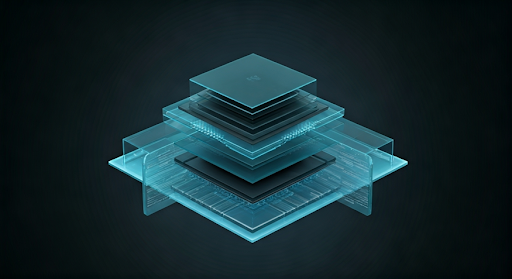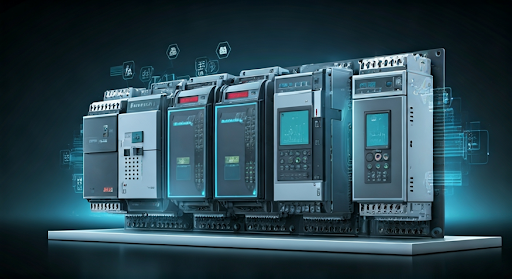Your Complete Guide to PLC Programmable Controller
Key Highlights
- Programmable logic controllers (PLCs) are robust industrial computers essential for industrial automation, offering precise control over machinery and processes.
- Modern PLC programming software and programming languages, such as ladder logic and function block diagrams, empower users to tailor automation for complex operations.
- Top PLC manufacturers like Rockwell Automation and Schneider Electric deliver solutions for harsh industrial environments and diverse industrial applications.
- Modular and fixed PLCs are both widely used, each with specific advantages for various manufacturing processes.
- Seamless communication protocols and system integration make PLCs central to data exchange and real-time process control across industrial
automation systems.
Introduction
Programmable logic controllers (PLCs) are at the heart of industrial automation, transforming how industries manage and control their machinery. Using advanced programming software, PLCs enable real-time monitoring, data acquisition, and automation of complex processes. Their adaptability and reliability support a wide variety of industrial environments, from manufacturing plants to remote facilities. As you explore PLCs in this handbook, you’ll discover how they empower industries to achieve greater safety, efficiency, and flexibility—paving the way for smarter automation and innovative manufacturing solutions.
The Evolution of Programmable Logic Controllers (PLCs)

Programmable Logic Controllers (PLCs) have transformed industrial automation since their inception in the late 1960s. Originally designed to replace relay-based control systems, these robust devices quickly evolved to accommodate complex operations across various sectors. Modern PLCs excel in data acquisition, process control, and interfacing with input/output devices, employing diverse programming languages like ladder logic and function block diagrams. This evolution facilitates seamless communication within automation systems, enabling efficient management of manufacturing processes and ensuring reliability in harsh industrial environments.
Origins and Historical Milestones in PLC Development
The story of PLCs begins in the late 1960s, when the manufacturing industry needed a more flexible alternative to hard-wired, relay-based control systems. These early relay panels, although robust, were time-consuming to rewire and update, causing delays in production when processes changed. The invention of the PLC offered a programmable memory and robust design that transformed control program management, allowing swift adaptation to evolving industrial needs.
PLCs introduced a new era with features such as data acquisition, real-time process control, and sequencing. The ability to reprogram logic without extensive hardware changes drastically improved uptime and reduced costs. Over time, PLCs became central to monitoring input and output devices, managing output signals, and integrating with human machine interfaces for better operator interaction.
Today, modern PLCs have advanced to handle complex automation, motion control, and even support remote locations through advanced communication protocols. Their evolution continues to drive the efficiency and safety of manufacturing systems, proving indispensable in industrial automation.
Main functions and applications of PLCs in modern manufacturing systems:
PLCs control and automate everything from assembly lines and robotic cells to process control in energy and water treatment plants, ensuring precision, reliability, and adaptability in industrial environments.
Influential Manufacturers and Their Innovations
Prominent PLC manufacturers have played a crucial role in shaping the capabilities and standards of programmable logic controllers. Companies like Rockwell Automation and Schneider Electric offer programmable controllers designed for harsh environments, with scalable options for both small and extensive automation projects.
These manufacturers continually innovate, introducing new models with enhanced communication protocols, greater memory, and robust security for industrial applications. Their focus on user-friendly programming software and modular architecture has expanded the possibilities for process control and data handling.
Below is a table highlighting some key PLC manufacturers and their unique contributions:
| Manufacturer | Notable Innovations & Features |
|---|---|
| Rockwell Automation | Allen-Bradley PLCs, dominant in North America, user-friendly programming, modular I/O |
| Siemens | Advanced engineering tools, broad model range, global support |
| Schneider Electric | EcoStruxure IoT integration, strong protocol compatibility, emphasis on sustainability |
| Mitsubishi Electric | Compact, high-performance PLCs, affordable options |
| Omron | Safety-focused design, intuitive user interfaces, advanced sensing technology |
How can I find reliable vendors for high-quality PLCs?
Look for established manufacturers with proven reliability, broad support networks, and the ability to meet both environmental and industry-specific needs. These leaders ensure strong technical support and a track record of industrial success.
Understanding the Core Architecture of a PLC

The efficiency and adaptability of a PLC system come from its well-designed core architecture. Inside every PLC, various internal components work together to execute control programs and manage industrial processes. At its heart, a PLC makes rapid decisions based on inputs, then adjusts outputs to control machinery and processes in real time. Let’s break down the essential hardware design, input and output modules, and how these pieces create a seamless process control system.
Key Internal Components and Hardware Design
At the core of every PLC is a specialized industrial computer engineered for robustness and reliability. The hardware design includes several critical components, each serving a specific function within the PLC system. The power supply ensures stable operation, even in environments with electrical noise or fluctuations—vital for harsh industrial applications.
Central to the PLC is the processor, or CPU, which executes the control program and manages all data handling tasks. Memory modules store the control logic and data, supporting both short-term processing and long-term retention of configurations. Input and output (I/O) modules are designed for flexibility, allowing integration with a variety of sensors, switches, and industrial machinery.
A human machine interface (HMI) connects operators directly to the PLC, enabling real-time monitoring and user interaction. The robust design of these components gives PLCs the durability to function reliably in demanding industrial environments, where extreme temperatures and vibrations are commonplace.
Can you describe the basic internal components and architecture of a PLC?
A PLC’s basic architecture includes the processor (CPU), memory, power supply, input/output modules, and optional interfaces like HMIs, all housed in a sturdy enclosure to withstand industrial conditions.
Input, Output, and Processing Modules Explained
PLCs excel at managing data from a variety of input and output devices, making them ideal for comprehensive process control. Input modules collect information from sources such as sensors, limit switches, and operator panels. Output modules use this data to send signals to actuators, motors, alarms, or visual indicators—ensuring precise control of machinery.
The processing unit acts as the brain, executing the control program based on the current inputs and sending appropriate output signals. This continuous cycle maintains real-time data handling and process reliability.
Key features of PLC I/O and processing modules:
- Input devices: Monitor on/off states, analog sensors (temperature, pressure), and user interfaces.
- Output devices: Control relays, motors, valves, alarms, and visual indicators.
- Processing unit: Executes control logic, data acquisition, and diagnostics for safe operation.
- Data handling: Manages real-time updates and system diagnostics.
- Output signals: Enable accurate and timely process adjustments.
How do PLCs contribute to safety and reliability in industrial automation?
PLCs provide fast, accurate responses to changing process conditions, include built-in diagnostics, and safely handle critical operations, significantly reducing the risk of failure or accidents.
Types of PLCs and Their Industrial Applications

PLCs come in different sizes and configurations to suit a range of industrial applications. The two most common types—modular and fixed PLCs—each offer unique benefits for process control and automation systems. While fixed PLCs are compact and cost-effective for standalone tasks, modular PLCs provide scalability and flexibility for larger, more complex manufacturing processes. The right PLC type can ensure reliable performance in industries from energy and food production to water treatment and beyond.
Fixed vs. Modular PLCs: Comparison and Use Cases
Fixed and modular PLCs are the primary types used across various industries. Fixed PLCs have a pre-defined number of input and output channels and are built as a single unit. Their compact, all-in-one design makes them affordable and easy to deploy for simple automation tasks or in harsh industrial environments where space is limited and operations are straightforward.
Modular PLCs, in contrast, offer flexibility through interchangeable modules for I/O, communications, and memory expansion. These PLCs are ideal for the manufacturing industry where motion control and process complexity demand scalable solutions that grow with operations.
Industries select PLC types based on the scale and needs of the application:
- Fixed PLCs: Small machines, standalone equipment, or applications where cost and space efficiency are crucial.
- Modular PLCs: Large manufacturing lines, facilities with evolving process needs, and situations requiring easy troubleshooting and minimal downtime.
What are the most common types of PLCs, and what industries use them?
Fixed PLCs are common in packaging, food processing, and small machinery. Modular PLCs dominate in automotive, chemical, and large-scale manufacturing operations.
Industry-Specific PLC Implementations (Manufacturing, Energy, etc.)
In manufacturing, PLCs streamline complex operations through precise control of machinery, using programming languages like ladder logic for seamless automation. Energy sector implementations leverage rugged designs to withstand harsh environments, allowing for real-time monitoring and data handling. Different industries utilize various modular PLC configurations, enhancing adaptability in diverse applications, from motion control to supervisory control. Communication protocols facilitate effective data exchange between input devices and output signals, ensuring optimal performance in industrial automation systems.
Common Functions and Capabilities of PLC Systems
Modern PLC systems excel in real-time control and supervisory functions, making them essential for automation. They handle data acquisition, process monitoring, and the control of machinery with impressive speed and reliability. These capabilities extend to complex operations, where programmable logic ensures efficiency and safety. System integration and seamless data exchange with other industrial systems further maximize the effectiveness of PLCs in manufacturing and process industries. Next, we’ll explore specific features that set PLCs apart.
Real-Time Control and Monitoring Features
Real-time control is a hallmark of PLC-based automation. PLCs constantly scan input devices, rapidly process acquired data, and issue output signals to control machinery and equipment. This cycle repeats in milliseconds, enabling immediate response to changing conditions on the production floor.
PLCs are designed for supervisory control and environmental monitoring, ensuring that industrial processes remain within safe, predefined parameters. Built-in diagnostics and error-checking functions support quick identification and resolution of faults, minimizing downtime and safeguarding both equipment and personnel.
Complex operations are managed with precision, from sequencing motion control in robotic systems to scheduling process steps in chemical production. This reliability and adaptability make PLCs indispensable for manufacturers who demand consistent performance in harsh industrial environments.
What are the main functions and applications of PLCs in modern manufacturing systems?
PLCs deliver real-time control, safety monitoring, process sequencing, production data logging, and remote supervisory capabilities.
Communication Protocols and System Integration
Seamless communication is vital in modern industrial automation. PLCs support a variety of communication protocols—enabling data exchange not only within a plant but also with remote locations through the industrial internet of things (IIoT). This connectivity allows PLCs to integrate with SCADA, MES, and ERP systems for holistic process management.
System integration is further enhanced by modular design and compatibility with diverse network standards, ensuring robust, secure, and scalable automation systems. Key PLC communication features include:
- Support for standard protocols (EtherNet/IP, Modbus, Profibus, etc.)
- Secure data exchange between PLCs and edge or cloud devices
- Real-time monitoring and control from remote locations
- Integration with HMI and SCADA for operator oversight
- Compatibility with IIoT architectures for advanced analytics
How do PLCs contribute to safety and reliability in industrial automation?
By enabling instant data sharing, remote monitoring, and centralized control, PLCs improve the reliability, safety, and efficiency of industrial operations.
Comparing PLCs with Other Industrial Controllers
Industrial automation uses a range of programmable controllers, from traditional relay-based systems to modern microcontrollers and PLCs. The main difference lies in flexibility, programming capability, and suitability for harsh environments. PLCs outperform relay systems with programmable memory and robust design, while also providing more scalability and adaptability compared to microcontrollers. Understanding these differences helps you choose the right solution for your automation needs. Let’s look closer at the distinctions between these controllers.
PLCs vs. Relay-Based Control Systems
Relay-based control systems, once the industry standard, use physical switches and wiring to manage output devices. While known for their robust design and ability to operate in extreme temperatures, these systems are limited by manual wiring and inflexible logic. Changes in process control require time-consuming rewiring, leading to costly downtime.
PLCs, on the other hand, store their control program in programmable memory, making logic changes fast and easy without altering the hardware. They support advanced diagnostics, better handling of output signals, and can seamlessly scale to more complex operations.
Advantages of PLCs over relay-based systems include:
- Faster reprogramming and updates
- Reduced wiring and installation complexity
- Enhanced diagnostics and monitoring Disadvantages:
- Higher upfront cost
- Requires knowledge of programming languages
What are the advantages and disadvantages of using PLCs compared to traditional relay-based control systems?
PLCs offer flexibility, speed, and scalability, but require trained personnel and a higher initial investment.
PLCs vs. Microcontrollers and Other Automation Devices
Microcontrollers are small, programmable chips used in custom automation devices. While both microcontrollers and PLCs can run control programs and manage output signals, there are important differences. Microcontrollers excel in embedded or consumer electronics, but lack the rugged design and comprehensive I/O options needed for industrial environments.
PLCs provide programmable memory, industrial-grade hardware, and user interfaces designed for harsh environments. They offer extensive expansion modules, support multiple programming languages, and easily integrate with other automation systems.
How does a PLC differ from other types of industrial controllers?
Unlike microcontrollers, PLCs are purpose-built for industrial applications, featuring robust construction, easy reconfiguration, and long-term reliability in demanding settings.
Fundamentals of PLC Programming
Effective industrial automation relies on well-structured PLC programming. Using PLC programming software, engineers develop control programs in a range of programming languages, from ladder logic to function block diagrams. These languages help create intuitive, reliable solutions tailored to specific industrial processes. Best practices in coding, simulation, and testing ensure that PLC-driven automation systems perform optimally and safely. Below, we’ll examine the key programming tools and techniques you need to know.
Popular Programming Languages and Software Tools
PLCs support several standardized programming languages, each catering to different user preferences and application requirements. Ladder logic is the most popular, resembling traditional electrical schematics, making it easy for technicians to adopt. Function block diagrams (FBDs) allow engineers to visually map control logic, while sequential function charts (SFCs) provide a graphical approach to process sequencing.
Common PLC programming languages and software tools:
- Ladder Logic: Ideal for discrete control and straightforward automation tasks.
- Function Block Diagrams: Best for process control and complex signal handling.
- Sequential Function Charts: Useful for step-by-step process automation.
- Structured Text: A high-level language for advanced data handling and algorithms.
- Programming software: Studio 5000, Connected Components Workbench, and RSLogix 500 are widely used for various PLC platforms.
How do you program a PLC, and what are the typical programming languages used?
Programming is done via specialized software using languages like ladder logic, FBD, SFC, and structured text, depending on the application.
Best Practices for Coding, Simulation, and Testing
Programming a PLC goes beyond just writing code; it involves simulation, testing, and careful data handling to ensure reliable operation. The first step is to outline your control program using the most suitable language and organize the logic for clarity and troubleshooting ease. Simulation tools provided by modern PLC programming software allow for offline validation, reducing the risk of errors during live deployment.
Testing in a controlled environment is crucial. By connecting your PLC to a user interface or HMI, you can observe how it responds to simulated inputs and outputs. Comprehensive testing ensures that all logic branches are exercised, and that process control is maintained under all operating conditions.
Finally, thorough documentation and version control make future updates and troubleshooting straightforward, supporting long-term system reliability.
How do you program a PLC, and what are the typical programming languages used?
After coding in the chosen language, simulation and systematic testing guarantee the PLC operates safely and meets process requirements.
Essential Considerations for Selecting a PLC Vendor and System
Choosing the right PLC manufacturer and system is pivotal for successful industrial automation projects. Quality and reliability must be matched with the ability to withstand harsh environments and support complex industrial processes. When evaluating PLC vendors, consider their reputation, the robustness of their products, and the breadth of support services offered. Look for vendors with a proven track record in similar applications, as well as global or local presence for timely assistance.
System compatibility is another key factor. The PLC should integrate seamlessly with your existing automation systems and communication protocols. Prioritize modularity for future expansion and ensure comprehensive documentation and training resources are available. By carefully weighing these factors, you set the foundation for a resilient, scalable, and efficient automation solution that aligns with both current and evolving industrial needs.
Evaluating Quality, Reliability, and Support for US-based Projects
Assessing a PLC vendor for US-based industrial projects requires a thorough review of several critical factors. Focus on vendors with a longstanding reputation for high-quality, reliable products engineered to withstand demanding environmental conditions. Evaluate the support infrastructure—does the company offer responsive technical support, localized service centers, and comprehensive training?
Key considerations for evaluating US-based PLC vendors:
- Quality: Look for certifications, industry awards, and user feedback on product consistency.
- Reliability: Prioritize systems proven to operate in harsh industrial environments, such as extreme temperatures or high vibration.
- Support: Choose vendors with strong local presence, fast response times, and extensive documentation.
- Compatibility: Ensure the PLC integrates with your current automation systems, communication protocols, and future expansion plans.
- Environmental durability: Select models rated for the specific conditions of your facility or process.
What key factors should be considered when selecting a PLC for an industrial application?
Focus on vendor reputation, product robustness, support availability, compatibility with your systems, and suitability for the environmental conditions in your application.
Conclusion
In conclusion, understanding and leveraging the potential of Programmable Logic Controllers (PLCs) is essential for modern industrial applications. From their historical evolution to their core architecture and programming fundamentals, PLCs offer unmatched capabilities in real-time control and monitoring. As you explore various types of PLCs and their specific applications across industries, it becomes evident that choosing the right system can significantly enhance operational efficiency. Whether you're a seasoned professional or just starting in the field, staying informed about the latest developments and best practices is crucial. If you need further assistance, feel free to reach out for a consultation to help you unlock the full potential of PLC technology.
What is PLC, and why do we use it?
A PLC, or Programmable Logic Controller, is an industrial digital computer designed for automation of manufacturing processes. It monitors inputs and controls outputs to ensure efficient operation. PLCs enhance reliability, reduce human error, and improve productivity by automating repetitive tasks in various industries, making them essential for modern automation systems.
What is PLC, and why do we use it?
PLC stands for Programmable Logic Controller, a digital computer used for automation of industrial processes. It monitors inputs, makes decisions based on programmed logic, and controls outputs to automate machinery. PLCs enhance efficiency, reliability, and flexibility in manufacturing and production environments by streamlining operations and minimizing human intervention.



